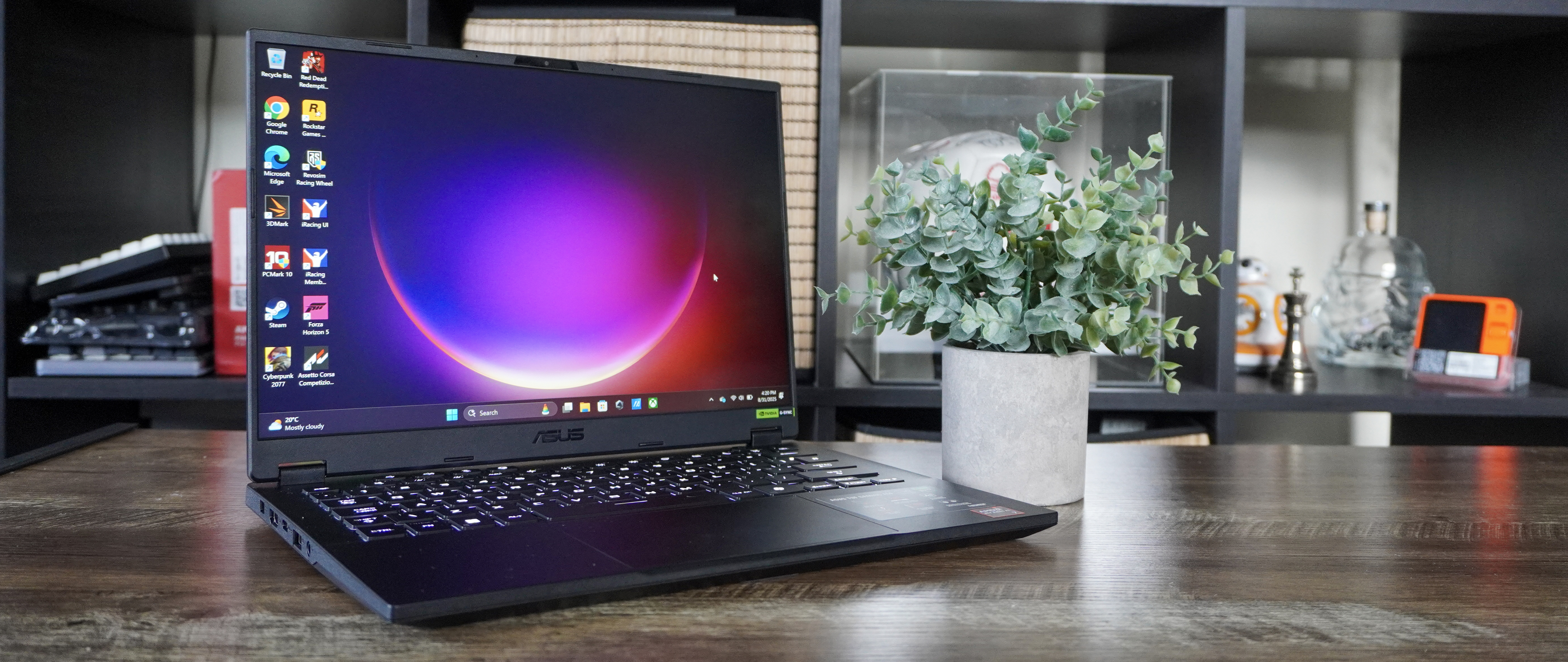Tom's Guide Verdict
The 2025 Asus TUF Gaming A14 is a great gaming laptop for mid-rangers — packing RTX 5060 performance into that familiar (and sleek) durable chassis design. But that price hike is giving me pause — especially given how small the in-game performance gains are over last year’s model.
Pros
- +
Same great design
- +
AMD Ryzen AI + RTX 5060 horsepower
- +
Impressive QHD+ display
- +
Good gaming battery life
Cons
- -
Price hikes across the board
Why you can trust Tom's Guide
One year ago, I called the first Asus TUF Gaming A14 my personal favorite gaming laptop of the year. And with the 2025 model sporting an RTX 5060, that is still the case…ish. Look, can we talk for a second? Because gaming laptops are heading in the wrong direction.
Because yes, in terms of what you get, this is pound-for-pound one of the best ultraportable gaming machines I’ve used. The body still feels nice and premium, the CPU may have been downgraded but not enough to feel any overt hit to performance, the GPU unlocks all the DLSS 4 goodness including multi-frame gen.
But prices have been creeping up across the board. In the UK, the retail price is £1,599 — that’s £300 more than the RRP of last year’s model. Luckily, it’s regularly on sale for around the £1,300 mark, so this just feels like a number that Asus uses to make the actual price feel like a discount.
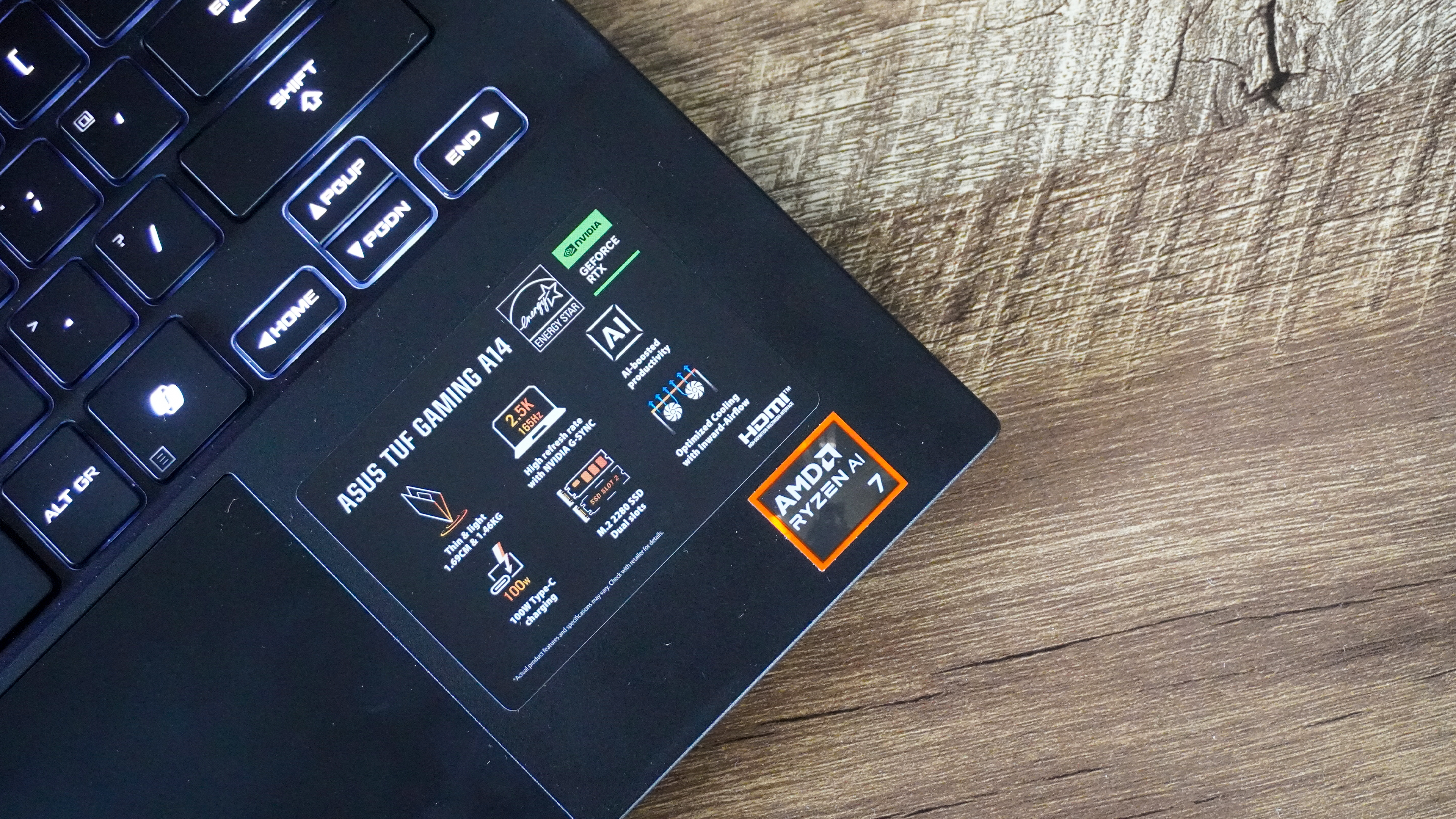
But in America? No such discount. That price has gone up by $200 to $1,699. To Asus’ credit, this doesn’t seem like an issue only this company is facing, as others have seen relatively mid-range models shoot up in cost like this.
That being said, it doesn’t make things any less frustrating to know that the gaming laptop market is moving in the wrong direction rather than staying still — especially at a time when we’re having to really look after the dollars and cents.
So when I say “ish,” I mean that fundamentally it’s a great laptop. But when the RTX 4060 model can be found for $1,199 nowadays, and the performance difference is definitely much more iterative when I faced it off against RTX 5060, those extra frames are definitely not worth an extra $500.
Asus TUF Gaming A14: Cheat Sheet
- What is it? This is a mid-range 14-inch gaming laptop
- Who is it for? It’s ideal for portable PC gamers who want a solid 1080p/1440p system without looking for something gigantic.
- What does it cost? Retail prices come in at $1,699 in the U.S., and £1,349 in UK (discounted from £1,599).
- What’s good about it? RTX 5060 power brings some nice iterative uplifts in performance over the 4060 of the 2024 model, while sporting that same slimline, sleek durable construction with great ergonomics I fell in love with last year.
- What’s not so good? There’s only one, and it’s a big one. Price hikes across the board.
Asus TUF Gaming A14: Specs
Price | $1,699 |
CPU | AMD Ryzen AI 7 350 |
GPU | GeForce RTX 5060 |
RAM | 16GB LPDDR5 |
Storage | 1TB PCIe Gen 4x4 SSD |
Display | 14-inch 2.5K 2560 x 1600 pixels, IPS display, 165Hz |
Ports | 2x USB 3.2 Gen 2 Type-A, 1x USB 4 Type-C, 1x USB 3.2 Gen 2 Type-C, 1x HDMI 2.1, 1x 3.5mm audio combo jack, Micro-SD card reader |
Battery | 73Wh |
Wireless connectivity | Wi-Fi 6E and Bluetooth 5.3 |
Dimensions | 12.2 x 8.9 x 0.7 inches |
Weight | 3.2 pounds |
Asus TUF Gaming A14: The ups
Let’s start with the positives. Like I said, this was my favorite laptop of 2025, and my favorite just got that little bit better.
Get instant access to breaking news, the hottest reviews, great deals and helpful tips.
Mid-range gaming tune-up
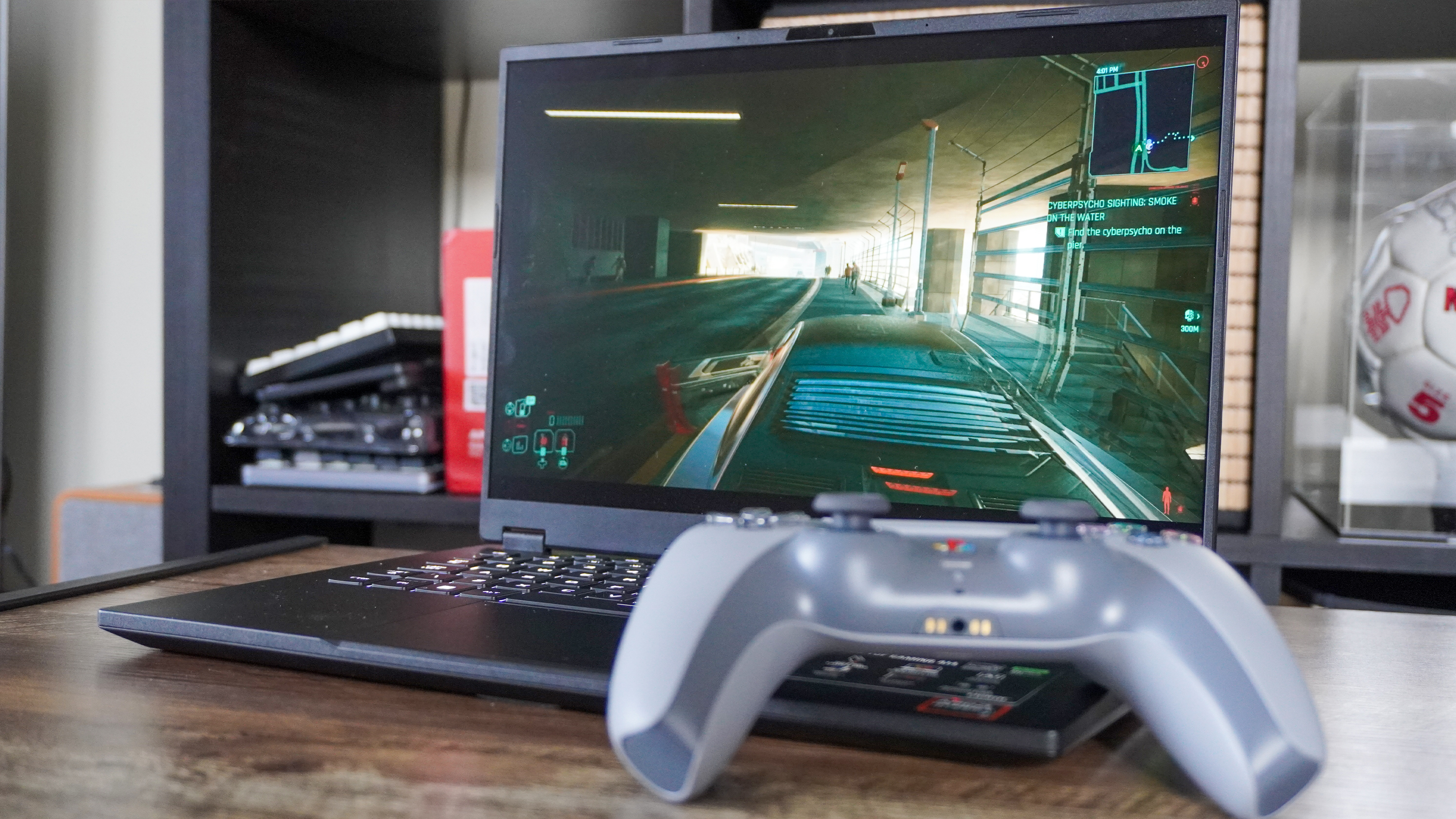
What impressed me the most about the 2024 A14 is the solid mid-range performance paired with some pretty impressive power efficiency. With the move to RTX 5060, it’s more of the same but with an uplift to both of them.
Yes, moving to the AMD Ryzen AI 7 350 CPU is technically a downgrade to the AI 9 HX 370 you found in last year’s grand debut of the A14. However, as you’ll see in CPU testing, the differences are pretty small (aside from creative pro work), and there is zero bottlenecking of that RTX 5060’s GPU prowess. Also, shoutout to the nice SSD speed bump too!
Laptop | Geekbench 6 single-core | Geekbench 6 multicore | Handbrake transcode 4K video to 1080p (mm:ss) | SSD read/write speed (25GB file transfer) |
|---|---|---|---|---|
Asus TUF Gaming A14 (2025 - AMD Ryzen 7 AI 350) | 2878 | 12693 | 04:18 | 1904 MBps |
Acer Nitro V 16S AI (AMD Ryzen 7 260) | 2659 | 12837 | 04:32 | 1839 MBps |
Asus TUF Gaming A14 (2024 - AMD Ryzen 9 AI HX 370) | 2863 | 13729 | 03:22 | 1566 MBps |
Moving on over to the GPU itself, in terms of raw performance, the uplifts are iterative between this and the 4060 in last year’s system. But as I’ll explain, that’s by design.
Laptop | 3DMark benchmark average score | Cyberpunk 2077 (1080p Ultra) | Red Dead Redemption 2 (1080p Ultra) | Shadow of the Tomb Raider (1080p Ultra) |
|---|---|---|---|---|
Asus TUF Gaming A14 (2025 - RTX 5060) | 8331 | 32.33 FPS | 39.5 FPS | 99 FPS |
Acer Nitro V 16S AI (AMD Ryzen 7 260) | 8497 | 31.87 FPS | 30 FPS | 99 FPS |
Asus TUF Gaming A14 (2024 - AMD Ryzen 9 AI HX 370) | 7320 | 29.6 FPS | 36.1 FPS | 92 FPS |
Because to catch you up, Nvidia is an AI company now with some gaming work on the side (which explains its $4.2T valuation). But Team Green has brought the two together with DLSS 4, multi-frame generation and a whole load of neural rendering tech that takes the RTX 5060 to a different level.
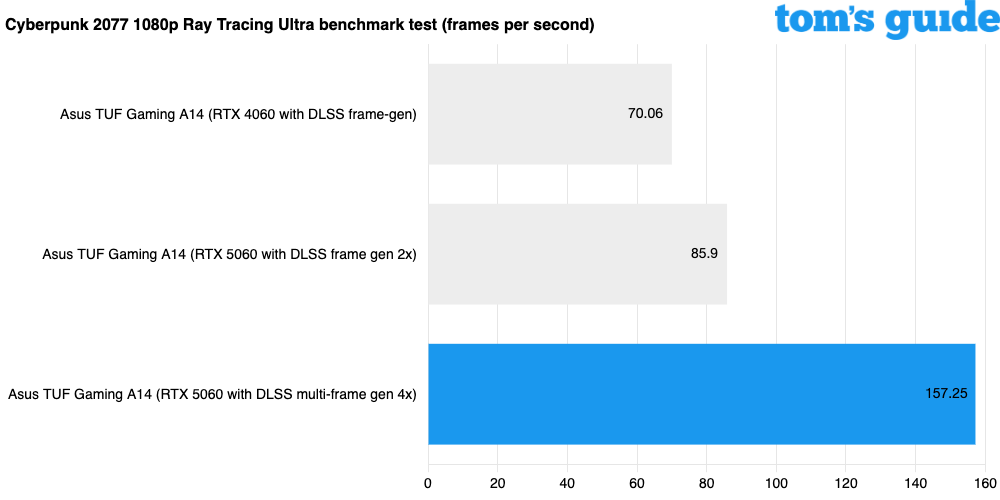
I understand the frustration with AI trickery when you’re buying a monster RTX 5090 or 5080 — at those prices, you understandably want these increases to be seen through actual rendering rather than inserting AI frames. But in something mid-range like this, it’s become a real value unlocker in what you can do with a gaming laptop.
Battery life is a different story, but not something you'll notice in day-to-day.
Laptop | Future battery life test (web browsing hh:mm) | 3DMark gaming battery life test (hh:mm) |
|---|---|---|
Asus TUF Gaming A14 (2025 - AMD Ryzen 7 AI 350) | 11:10 | 01:45 |
Acer Nitro V 16S AI (AMD Ryzen 7 260) | 10:17 | 02:30 |
Asus TUF Gaming A14 (2024 - AMD Ryzen 9 AI HX 370) | 12:05 | 01:47 |
I have a theory for why this is the case, as Asus has been able to up the wattage going to these components (more on why later).
Same great display and design with some tweaks
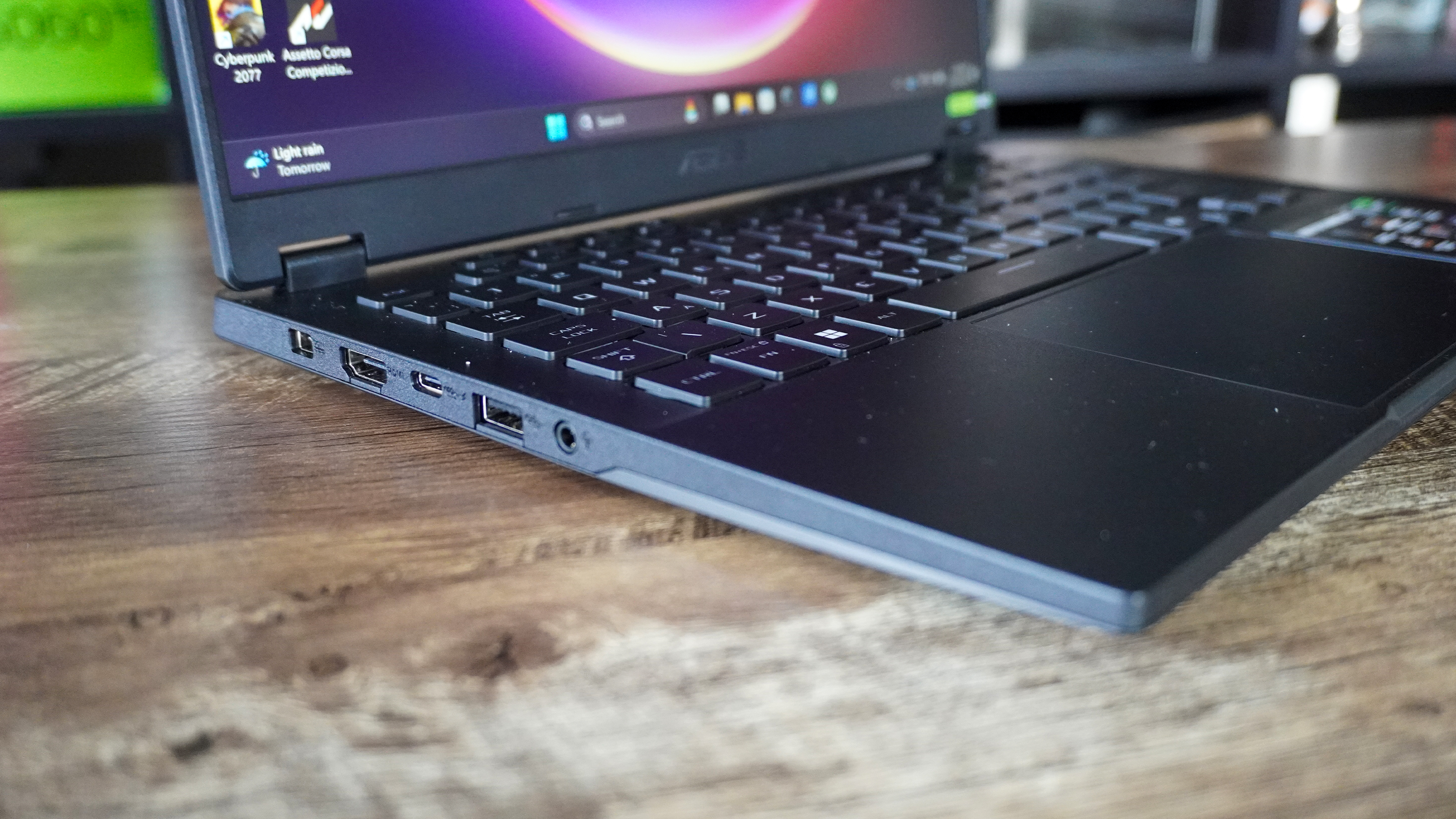
And they’ve kept arguably my favorite elements of this 14-inch beauty — the looks and the works of it all. The TUF Gaming A14’s built quality feels premium to the touch with a metallic top and bottom. And on top of that, the ventilation has been re-engineered to take air in through the keyboard deck to keep those internals cool.
Laptop | Touchpad temperature when gaming (Fahrenheit) | Keyboard temperature when gaming (Fahrenheit) | Hottest point temperature when gaming (Fahrenheit) |
|---|---|---|---|
Asus TUF Gaming A14 (2025) | 81.7 | 105.9 | 115.7 (top near the hinge) |
Acer Nitro V 16S AI | 108.3 | 83.6 | 119.6 (top center of keyboard deck) |
Asus TUF Gaming A14 (2024) | 77.5 | 89.5 | 111 (between f7 and f8 keys) |
Now, I know the main thing you’re thinking here: it’s actually warmer in some circumstances. But basically, the new thermal management means Asus has been able to turn up the wattage on components to extract more performance from them in the heat of gaming.
Looking elsewhere, that display is just as bright (393.6 nits average) and colorful (80.8% DCI-P3 color gamut) as last year’s model, and nicely smooth with that 165Hz refresh rate. And the keyboard and that touchpad still have that same tasty tactile feel to them. It’s a gaming laptop that doesn’t forget about the laptop elements of it all.
Asus TUF Gaming A14: The downs
Last year’s Asus TUF Gaming A14 posed real value for money. Now, the situation is just murky.
Very awkward pricing
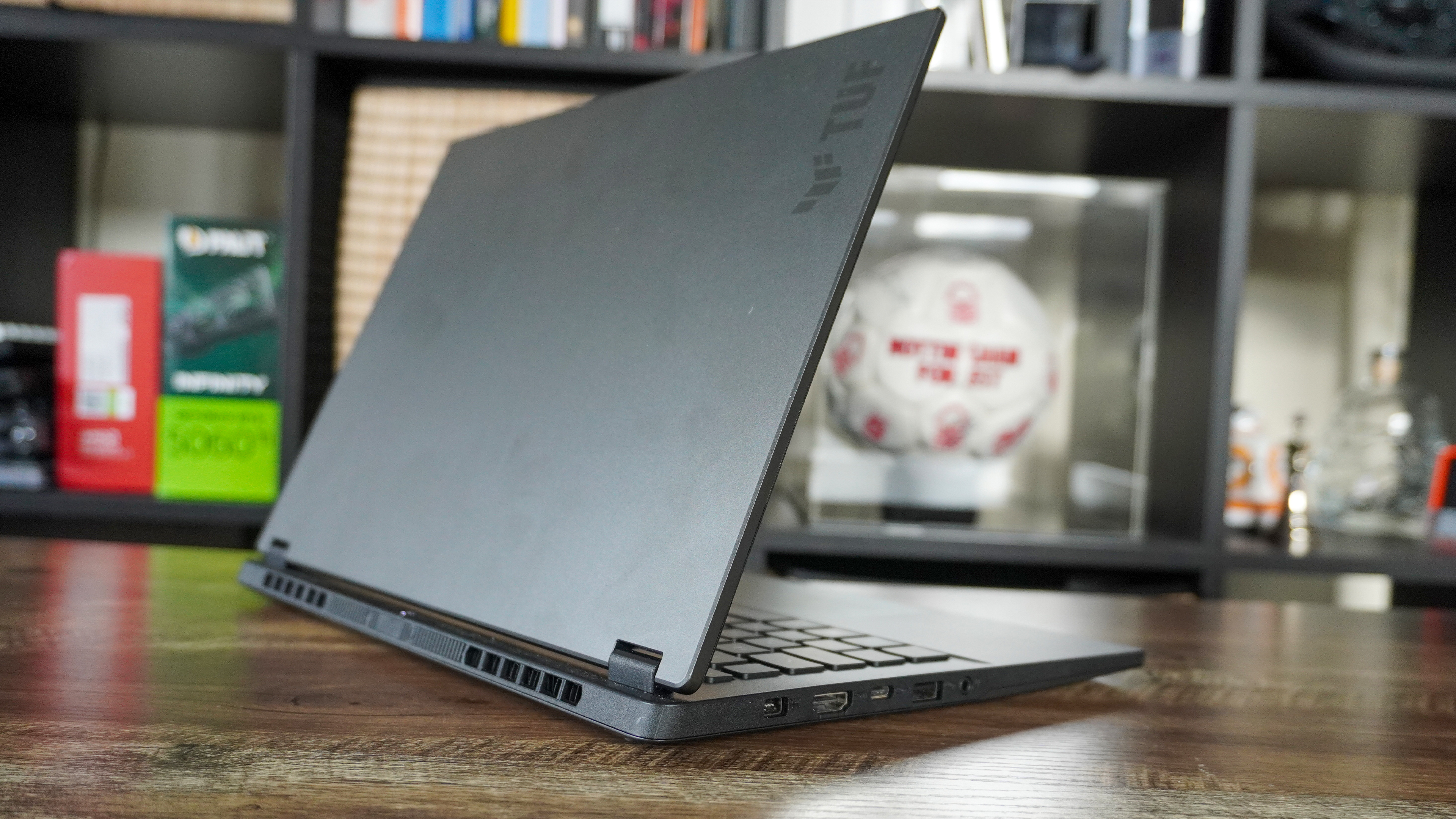
Looking back to 2024, we had a stellar gaming laptop with real attention paid to the laptop aspects of it. But the real killer aspect was the value for money of it all — $1,500 in the U.S. and £1,300 in the U.K.
But for 2025, prices have gone up by quite a margin. My fellow Americans are paying $200 more, and unless you get a deal, the RRP in the U.K. is up £300. I’m not going to say its price gouging a big seller in the lineup, but I can’t help but admit it feels like that.
It was that lower price that made last year’s model a must-buy in my eyes for anyone looking for a lower-price gaming laptop that isn’t bad. But in this economy, every penny matters, and you can get the same (and sometimes more) for less.
For example, the Acer Nitro V with near-identical specs but a 16-inch 180Hz display is $400 less at $1,299. Meanwhile looking to my homeland, while the A14 has been cut to £1,349 luckily (at that price, I’d recommend it), that doesn’t excuse it. The impressive Lenovo LOQ 15 with 5060 is £1,179 right now.
Gaming laptops are getting a bad rep recently for not offering anywhere near as good price-to-performance as they did 12 months ago (and earlier). This is not helping things.
Asus TUF Gaming A14: Outlook
Gripes aside, I can’t deny this is a fundamentally great gaming laptop with iterative upgrades across the board. It still sort of is my favorite gaming laptop, but it’s just the price that’s wrong for what you get, and that’s a heartbreaker.
I know that companies have been upping prices in anticipation of tariff impact, but I can’t say for sure whether that’s happened here. And at the end of the day, none of that matters — what actually matters in gaming laptops is that you’re getting bang for your buck.
And at this cost, you’re getting something equivalent to Mentos in Coca-Cola rather than a stick of dynamite. Still a decent bang, but not enough for the buck Asus is asking for.

Jason brings a decade of tech and gaming journalism experience to his role as a Managing Editor of Computing at Tom's Guide. He has previously written for Laptop Mag, Tom's Hardware, Kotaku, Stuff and BBC Science Focus. In his spare time, you'll find Jason looking for good dogs to pet or thinking about eating pizza if he isn't already.
You must confirm your public display name before commenting
Please logout and then login again, you will then be prompted to enter your display name.
